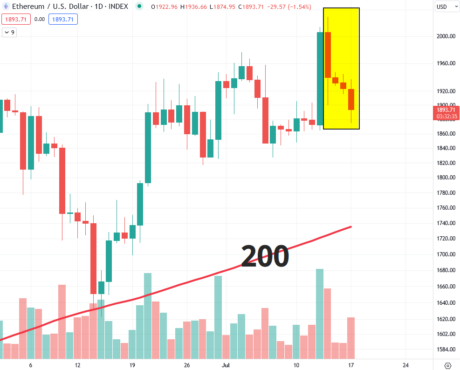[ad_1]
While most crypto market watchers stay centered on Bitcoin’s ongoing wrestle with $31,000, Ethereum just lately closed above the psychologically essential $2000 degree for the primary time in weeks. Now poised to shut decrease for 4 straight days, let’s take an evidence-based method and decide whether or not 4 consecutive days decrease for Ether is traditionally bullish or bearish going ahead. Let’s dive in!
Ethereum’s Close Above $2000 Followed By Pullback
After closing at a powerful multi-week excessive and again above the $2000 degree on July thirteenth, Ether has pulled again for 4 consecutive classes, one of many circumstances we’ll take a look at momentarily. To higher add context to the take a look at, we’ll additionally add two extra circumstances requiring that [1] Ether is above its 200ma and that [2] its 200ma is rising. Why? The 200ma and its slope each act as easy filters to assist decide market regime. For instance, this newest 4 day pullback in Ether happens in an enhancing market wherein ETH is above the rising 200ma. If the present 4 day pullback had been occurring in a down trending market regime, we might require that ETH be under its declining 200ma.

Ethereum Daily Chart | ETHUSD on TradingView.com
What does this pullback in Ethereum counsel for its worth? To discover out, we’ll have a look at all indicators since inception, and likewise examine these indicators to a easy “buy and hold” method. This will present us with a baseline to raised perceive as we speak’s take a look at outcomes.
Four Days Down Compared To Buy And Hold
The holding time graphic under reveals historic outcomes for Ether’s present technical setup on prime with a easy “buy and hold” method on the underside. In different phrases, we’ll present hypothetical outcomes utilizing varied holding occasions solely for when Ethereum has closed decrease for 4 straight days whereas above its rising 200ma on prime. The backside outcomes will act as a baseline, assuming a hypothetical buy of ETHUSD with no circumstances by any means and an exit n-days later.

Average Trade Comparison | SOURCE: REKTelligence, Tableau
While each approaches present optimistic common commerce outcomes over each exit we examined from 7 days via 90 days, our baseline “buy and hold” truly outperforms the present technical setup of 4 days down. The single exception is the “exit in 90 days” wherein the present setup barely outpaces the historic common “buy and hold” commerce, beating it 62.1% to 59.4%.
But whereas the common commerce statistic stays essential, it doesn’t at all times inform the entire story. When a comparability of the most important hypothetical losses for each approaches utilizing the identical circumstances described earlier, notice that the most important losses (i.e., worst trades) for the present 4 days down setup are far decrease than for a easy “buy and hold” method. This largest loss comparability signifies that whereas the present setup might not beat “buy and hold” when it comes to common commerce, Ethereum might at present have a decrease than normal danger publicity – one thing most skilled merchants will respect.

Largest Loss Comparison | SOURCE: REKTelligence, Tableau
While the previous doesn’t predict future, based mostly on our evaluation, Ethereum seems poised for potential upside principally consistent with typical “buy and hold” expectations. In different phrases, not overly thrilling and apparently missing any significant edge in the meanwhile. That stated, danger additionally seems decrease than normal relative to the “buy and hold” largest loss stats. Traders take notice. Ethereum might now offer its typical return profile based mostly on its present technical setup, however with a decrease general danger publicity.
DB the Quant is the creator of the REKTelligence Report publication on Substack. Follow @REKTelligence on Twitter for evidence-based crypto market analysis and evaluation. Important Note: This content material is strictly instructional in nature and shouldn’t be thought-about funding recommendation. Featured photographs created with Tableau. Charts from TradingView.com.
[ad_2]
Source link



